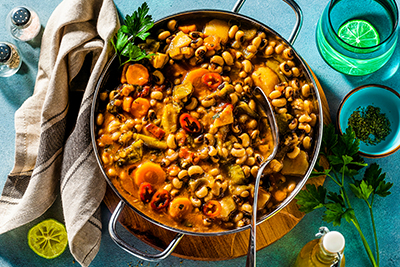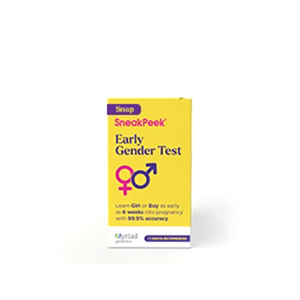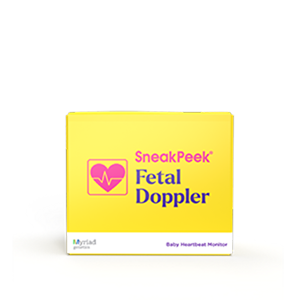Published on April 25th, 2022 and Updated on February 29th, 2024
Check out SneakPeek Gender Test to find out your baby’s gender as early as 6 weeks at over 99% accuracy1!
From genetics to lifestyle choices, there are a host of factors that influence female and male fertility. Female fertility is particularly complex. Two major factors play a role in your ability to get pregnant: egg quantity and egg quality.
If you’re trying to conceive, you may already know that a woman’s ovarian reserve (egg count) declines with age. Although there’s no way to increase the quantity of the eggs in your reserve, you might wonder if it’s possible for you to take control over the quality of the eggs in your reserve.
The answer is—sort of! With certain foods in your corner (and your fridge) you may be able to give your eggs a boost.
If you’re trying to conceive, a balanced diet is crucial for the nutrients you and your oocytes (eggs) need to increase your chances of success. Consider the guide below as your go-to grocery list for foods you can incorporate into your fertility diet to improve egg quality.
5 Foods To Eat On a Fertility Diet
Before we deliver our top contenders, let’s make one thing clear: while certain foods can support you on your pregnancy journey, there is no single food that can magically boost your egg quality.
The biggest factor in the quality of your oocytes is your age. The vitality of your oocytes begins to dip in your thirties, with the most pronounced decline occurring in women 35 and up.
That said, there are several ways to improve your egg quality before getting pregnant, but we’re going to focus on certain foods that have been linked to improved egg health and fertility overall. Let’s take a glance at the 5 best foods to chow down on for higher quality eggs when you’re trying to have a healthy pregnancy.
#1. Legumes
If there’s one nutrient to pay attention to for healthy egg quality, it’s folate. Folate, or folic acid, is a type of B vitamin that plays a critical role in fertility levels and early pregnancy:
- Folate is intimately involved in the reproductive system, from optimizing ovarian function to preventing defects of the brain and spinal cord in babies during pregnancy.
- One study found that women who took a folic acid supplement during IVF treatment had both higher-quality eggs and better egg development than women who went without it.
- Folate may not only promote better egg quality—it’s also been linked to higher egg production in women trying to get pregnant. The translation? The more folate you ingest, the more likely you are to successfully ovulate each month, increasing your chances of having a better fertility outcome and conceiving.
It’s recommended you consume between 400 and 1000 micrograms of folate per day if you’re trying to conceive—and the best way to get it is through legumes, an excellent source of folate. There are plenty of ways to work them into a healthy diet. Prepare to delight your tastebuds and boost your egg quality with dishes like:
- Dal (1 cup contains 358 mg of folate)
- Blackeye pea soup (1 cup offers 358 mg)
- Pinto bean dip (1 cup can provide approximately 294 mg)
What’s more, legumes are a complex carbohydrate—a type of macronutrient that’s considered essential for boosting overall fertility. They’re also rich in protein and antioxidants, which are both crucial for fertility, early pregnancy, and keeping your body’s oxidative stress levels low (we’ll say more on this later).
To get the most folate bang for your beans, skip the canned varieties, and buy them dry. Then, soak them overnight before you cook them.
If you’re not wild about beans, you can take a daily folate supplement, a prenatal vitamin with folate, or meet your quota with these other folate-rich foods:
- Lush, leafy greens, like spinach
- Peanuts and sunflower seeds
- Eggs
- Beets
- Bananas
- Avocados
#2. Egg Yolks
If you routinely ask for whites only in your omelets, consider switching your order the next time Sunday brunch rolls around.
Eggs yolks are packed with an oocyte quality-boosting power nutrient: vitamin b12. Vitamin b12 is a crucial vitamin for red blood cell production and oxygenating the body’s cells. It’s also been associated with improved pregnancy outcomes for both women pursuing natural pregnancy and those undergoing fertility treatment like IVF.
Vitamin b12 is predominantly found in animal protein like eggs, dairy, and meat. If you’ve nixed animal products from your diet, it’s important to get your quota from other sources. In addition to egg yolks, you can get vitamin B12 from:
- Milk, or a non-dairy vitamin b12-fortified milk (e.g. almond milk)
- Fortified cereal
- Full-fat yogurt
- Salmon
- Tuna
- Vitamin b12 supplements
#3. Salmon
Harvard Medical School names omega–3 fatty acids as one of the top fertility-boosting nutrients—and if there’s one food that’s an omega-3 jackpot, it’s salmon.
One study delivered to the American Society of Reproductive Medicine suggests that keeping up with omega-3 levels may elevate both the number of eggs in the ovarian reserves and the quality of the eggs.
Omega-3 fatty acids are primarily found in seafood like oily fish, and salmon takes the fish cake for healthy fat content compared to other fish in the sea. Farmed and wild-caught salmon contain 4,504 mg and 1,774 mg of omega-3s (respectively) per 6 oz. serving.
Some other top contenders are:
- Anchovies – 1,200 mg per 2 oz. serving
- Swordfish – 868 mg per 3.7 oz. serving
- Albacore tuna – 733 mg per 3 oz. serving
- Mussels – 665 mg per 3 oz. serving
Now, you may be wondering, can I eat seafood while I’m trying to get conceive? The answer is yes—but once you become pregnant, you may want to reduce how much you consume to ensure your mercury levels stay low.
If you’re vegan or vegetarian, you can also get omega-3s from:
- Walnuts
- Chia seeds
- Flax seeds
#4. Asparagus
South Asian cultures have traditionally used asparagus or shatavari as a fertility-enhancing tonic, and today, there’s plenty of science to explain why.
Asparagus root is a source of phytoestrogens, a type of compound that mimics the actions of estrogen. Asparagus root extract has also been found to increase and regulate other gonadotropins (reproductive hormones), including:
- Follicle-stimulating hormone (FSH)
- Luteinizing hormone (LH)
- Estrogen
- Progestin
One study concluded that asparagus root promotes fertility by interacting with these gonadotropins to enhance oogenesis—the process wherein your eggs come to maturity and a major determinate in their overall quality.
The takeaway? Make asparagus a staple side dish, soup base, or salad garnish, and spearhead your fertility like fellow women have been doing for centuries.
#5. Brassica Vegetables
Brassica vegetables are a hybrid genus that belongs to both the mustard and cabbage families. In your produce drawer, you’d recognize them as leafy green staples such as:
- Cabbage
- Kale
- Collard greens
- Broccoli
- Brussels sprouts
Understanding how brassica vegetables may enhance egg quality requires a little lesson in biology—specifically, the phenomenon of oxidative stress:
- Oxidative stress is a molecular phenomenon that occurs when there’s an imbalance between the free radicals (unstable molecules) and the antioxidants within your body. Having more free radicals than antioxidants can damage your cells, lead to inflammation, and throw a host of bodily systems out of whack—including your reproductive system.
- Specifically, oxidative stress can adversely impact egg quality. If your body is constantly in a state of oxidative stress, your tender eggs can bear the brunt of the damage.
- Brassica vegetables may help to offset oxidative stress by helping the body produce its own powerful antioxidant: glutathione.
Glutathione acts as a forcefield against the havoc oxidative stress can wreak on your ovaries, particularly during the follicular phase (the phase of your menstrual cycle when an egg matures in a follicle in preparation for ovulation). Research has shown that oocytes exposed to higher levels of glutathione can lead to stronger, healthier embryos once they’ve been fertilized.
Foods that are rich in sulfur, like brassicas, are known to boost glutathione synthesis, helping your body handle oxidative stress and contributing to a healthy environment for your oocytes to develop in.
What does all this mean for your next meal? Caramelize some broccoli, char some cabbage, and chow down on some kale. Learn about when to start taking prenatal vitamins to fill in those nutrient gaps and if alcohol can affect a pregnancy test. Your future baby will thank you for it.
Start Your Parenting Journey Early with SneakPeek
Want to learn another fun fact about the foods on this list? Not only can they lead to better egg quality, but, if you eat them during pregnancy, they can also influence your baby’s palate once he—or she—is born!
Learn whether your future eater will be a boy or a girl with the SneakPeek At-Home Early Gender Blood Test—the #1 OBGYN-recommended at home gender test. Delivering clinically-proven over 99% accurate1 results as early as 6 weeks into your pregnancy, it’s the only fetal sex test that can reveal your baby’s gender this early, months ahead of your 20-week anatomy ultrasound. No wonder it’s been chosen by over 1 million moms!
Prepare for your baby-to-be and your exciting journey into motherhood with answers and advice from SneakPeek Test.
This post has been reviewed for accuracy by the following medical professional:
Dr. Heather Soper, Certified Nurse Midwife
Dr. Heather Soper brings over 15 years of experience in women's health and obstetrics to her role as the owner of The Genesis Resort for Birth. Complementing her clinical practice, she serves as an Assistant Professor of Nursing at James Madison University, where she educates nursing students with a focus on compassionate, patient-centered care. Her advanced training and dedication to midwifery are evident in her contribution to both academia and the wellness of expectant mothers
Sources:
- National Institute of Health. Ovarian aging and infertility. https://pubmed.ncbi.nlm.nih.gov/23700864/
- American Pregnancy Association. Trying to Conceive After Age 35. https://americanpregnancy.org/getting-pregnant/trying-to-conceive-after-age-35/
- National Institute of Health. Folate Metabolism and Human Reproduction. https://www.ncbi.nlm.nih.gov/pmc/articles/PMC4175124/
- National Institute of Health. Diet and Fertility: A Review. https://www.ncbi.nlm.nih.gov/pmc/articles/PMC5826784/
- National Institute of Health. Folate intake and ovarian reserve among women attending a fertility center. https://pubmed.ncbi.nlm.nih.gov/34809974/
- Mayo Clinic. Folate (folic acid). https://www.mayoclinic.org/drugs-supplements-folate/art-20364625
- Contra Costa Health Services. Folic Acid and Folate Values for Selected Foods. https://cchealth.org/folic-acid/list.php
- National Institute of Health. Nutrition and fertility. https://pubmed.ncbi.nlm.nih.gov/30351153/
- Harvard Medical School. Fertility and diet: Is there a connection? https://www.health.harvard.edu/blog/fertility-and-diet-is-there-a-connection-2018053113949
- National Institute of Health. Association between serum folate and vitamin B-12 and outcomes of assisted reproductive technologies. https://www.ncbi.nlm.nih.gov/pmc/articles/PMC4588741/
- Cleveland Clinic. The Best Sources of Vitamin B12. https://health.clevelandclinic.org/the-best-sources-of-vitamin-b12-infographic/
- National Institute of Health. Effects of folate and vitamin B12 deficiencies during pregnancy on fetal, infant, and child development. https://pubmed.ncbi.nlm.nih.gov/18709885/
- Time. How Omega 3 Fats May Improve Fertility. https://time.com/4535182/how-omega-3-fats-may-improve-fertility/
- Harvard T.H. Chan School of Public Health. Omega-3 Fatty Acids: An Essential Contribution. https://www.hsph.harvard.edu/nutritionsource/what-should-you-eat/fats-and-cholesterol/types-of-fat/omega-3-fats/
- National Health Service UK. Foods to avoid in pregnancy. https://www.nhs.uk/pregnancy/keeping-well/foods-to-avoid/
- WebMD. What Not to Eat When You’re Pregnant. https://www.webmd.com/baby/ss/slideshow-what-not-to-eat-when-pregnant
- Healthline. 12 Foods That Are Very High in Omega-3. https://www.healthline.com/nutrition/12-omega-3-rich-foods#12.-Soybeans-(1,241-mg-per-serving)
- Times of India. 5 herbs that can help you get pregnant. https://timesofindia.indiatimes.com/life-style/parenting/getting-pregnant/5-herbs-that-can-help-you-get-pregnant/articleshow/83113935.cms
- National Institute of Health. Effects of aqueous extract from Asparagus officinalis L. roots on hypothalamic-pituitary-gonadal axis hormone levels and the number of ovarian follicles in adult rats. https://www.ncbi.nlm.nih.gov/pmc/articles/PMC4869160/
- Masterclass. Brassica Vegetable Guide: 15 Types of Brassicas. https://www.masterclass.com/articles/brassica-vegetable-guide#15-types-of-brassica-vegetables
- National Library of Medicine. Free Radicals, Antioxidants in Disease and Health. https://www.ncbi.nlm.nih.gov/pmc/articles/PMC3614697/
- National Library of Medicine. Review on the role of glutathione on oxidative stress and infertility. https://www.ncbi.nlm.nih.gov/pmc/articles/PMC5844662/
- National Library of Medicine. Antioxidants for female subfertility. https://www.ncbi.nlm.nih.gov/pmc/articles/PMC6483341/
- National Library of Medicine. Review on the role of glutathione on oxidative stress and infertility. https://www.ncbi.nlm.nih.gov/pmc/articles/PMC5844662/

Shop Our Products
SneakPeek aims to provide the most accurate and up-to-date information to help our readers make informed decisions regarding their health before, during, and after pregnancy. This article was written based upon trusted scientific research studies and/or articles. Credible information sources for this article are cited and hyperlinked.






